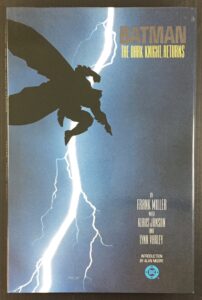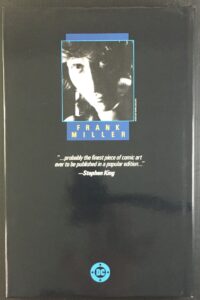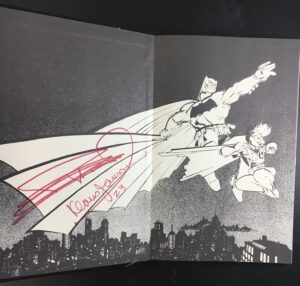The Dark Knight Returns
Batman: The Dark Knight Returns – The Book That Changed Everything
In 1986, Batman: The Dark Knight Returns hit comic shops and immediately reshaped the future of the Dark Knight—and the entire comic book industry. Its influence would be felt not just in comic books, but in television, movies, and pop culture in general. Written and drawn by Frank Miller with inks by Klaus Janson and colors by Lynn Varley, the four-issue prestige format series delivered a darker, grittier take on Batman that felt revolutionary at the time—and still holds up decades later.
Before Dark Knight, Batman’s popularity had cooled. The camp of the 1960s TV show still lingered in the public’s imagination, and while the 1970s had brilliant runs—especially with Neal Adams and Denny O’Neil reintroducing Batman as a more serious detective—momentum had faded by the mid ‘80s. DC needed a shake-up. They had seen what Frank Miller had done transforming Daredevil into a noir powerhouse at Marvel, and they wanted that energy for Gotham.
And wow, did they get it.
I was 14 years old when The Dark Knight Returns arrived with a new look and feel: a square-bound “prestige” format with glossy pages and heavier stock. At the time, that alone made it feel like something special. DC later used the same format for Green Arrow: The Longbow Hunters and The History of the DC Universe, but Dark Knight was the game-changer.
Each of the four books had its own title: The Dark Knight Returns, The Dark Knight Triumphant, Hunt the Dark Knight, and The Dark Knight Falls. Together, they told the story of a 55-year-old Bruce Wayne coming out of retirement a decade after Robin (Jason Todd) died. Gotham is overrun with crime, and the world has moved on from costumed heroes—except for Superman, who now works as a government enforcer.
Batman’s return isn’t just about vengeance; it’s a full-scale war for Gotham’s soul.
And Miller didn’t just reimagine Batman—he reimagined everything, including the way a comic book story could be told. The Batmobile became a hulking tank. The panels mimicked TV news broadcasts, offering media commentary that felt ahead of its time. And we got the debut of Carrie Kelley, the first female Robin—acrobatic, smart, and completely fearless.
The series is filled with unforgettable moments. Batman riding a black stallion through a storm. That iconic lightning bolt silhouette. Batman and Robin leaping into battle, with Miller’s signature tucked-leg pose. And, of course, the climactic showdown between Batman and Superman in the final issue—a battle between two old friends, now on opposite sides of ideology.
This wasn’t just a comic. It was a statement.
I still remember walking into my local comic shop and seeing that first issue on the rack. It felt like an event. It was the beginning of my obsession with Batman, one that lasts to this day. I ended up getting the Dark Knight hardcover that Christmas and have kept it pristine ever since. Years later, I finally had the chance to get it signed by Miller and Janson— I felt like Ralphie in A Christmas Story when he finally got his Red Ryder BB gun.
Often overlooked, Lynn Varley’s work also deserves serious praise. Her coloring brought a cinematic edge to the series, with moody tones and powerful contrasts. At a time when colorists were often overlooked or outright ignored, Varley’s name was right on the cover—something rarely done at the time. Her seminal work on the series was a landmark; her influence is still felt in how coloring is approached in the industry today.
The Dark Knight Returns helped change how comics were read and collected. After it was compiled into one volume, readers could enjoy the story all at once, instead of waiting for each chapter. It became a cornerstone of the growing graphic novel market and showed that comics could tell adult, complex stories. Along with Watchmen, it redefined the medium for a new generation of readers.
Today, the series is still as popular as ever. Original art from issue #1 recently sold for over $2 million at auction. Batman fans still debate it, revisit it, and recommend it. And for many of us, it was the story that turned a casual interest into a lifelong obsession.
Nearly 40 years later, it still feels like lightning in a bottle.
Rob Pillsbury




